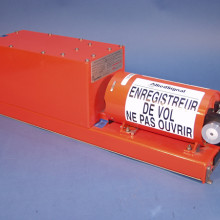Now that Malaysian Airways Flight MH370 has officially been acknowledged to have ended in the southern Indian Ocean with all lives lost, attentions have turned to recovering wreckage and piecing together what events might have lead to its crash. It's the aircraft's black box recorder which might hold the most clues.
In this episode

00:00 - Black Box Recorders
Black Box Recorders
Now that Malaysian Airways Flight MH370 has officially been acknowledged to have ended in the southern Indian Ocean with all lives lost, attentions have turned to recovering wreckage and piecing together what events might have lead to its crash. It's the aircrafts black box recorder which might hold the most clues. Here's your Quick Fire Science with Kate Lamble and Hannah Critchlow
- An aeroplane's black box is in most cases really two boxes painted a very visible bright orange
- One box contains the flight data recorder which stores 25 hours of information on the how the plane's operating systems are functioning - everything from altitude and airspeed to the movement of individual flaps on the wings.
- The other box contains the cockpit voice recorder which holds the last two hours of cockpit conversation. This continually records over itself while the flight is in the air.
- While investigators are interested in what the crew were doing just before the crash the voice recorder can also be used to hear background noise like emergency warnings in the cockpit and the engine noise.
- Black Boxes are required by international standards to withstand fires over 1000 degrees celcius, being immersed in salt water, deep sea pressure, and an impact velocity of 310 miles per hour.
- To help achieve this memory boards are covered with thick insulation and a steel or titanium shell and are stored near the tail section of the plane where they are less likely to be crushed. Some are designed to self-eject from a plane at the moment of impact.
- But all this insulation makes the box too heavy to float. Each recorder is therefore equipped with an underwater locator beacon which automatically begins to send out loud sonic pings when it is submerged.
- The beacon signal can be picked up a mile away but as the current search are covers over 35,000 square miles investigators are concerned that the black box will not be found before the recorders 30 day battery life expires.
- Another problem is that although sound travels extremely well underwater, in the deep ocean, layers of water at different temperatures and pressures known as thermoclines refract and bend the sound of the pings so that it's more difficult to locate.
- To help the search the US navy have brought in a 'towed pinger locator'. This highly sensitive listening device is lowered underwater to overcome this refraction and is capable of hearing black box pings at depth of up to 20,000 feet
- However, even if the black box from MH370 is not found within this time it does not mean it will never be recovered. The black box from Air France Flight 447 was found two years after the crash after autonomous unmanned submarines were used to scan the ocean floor with sonar.









Comments
Add a comment